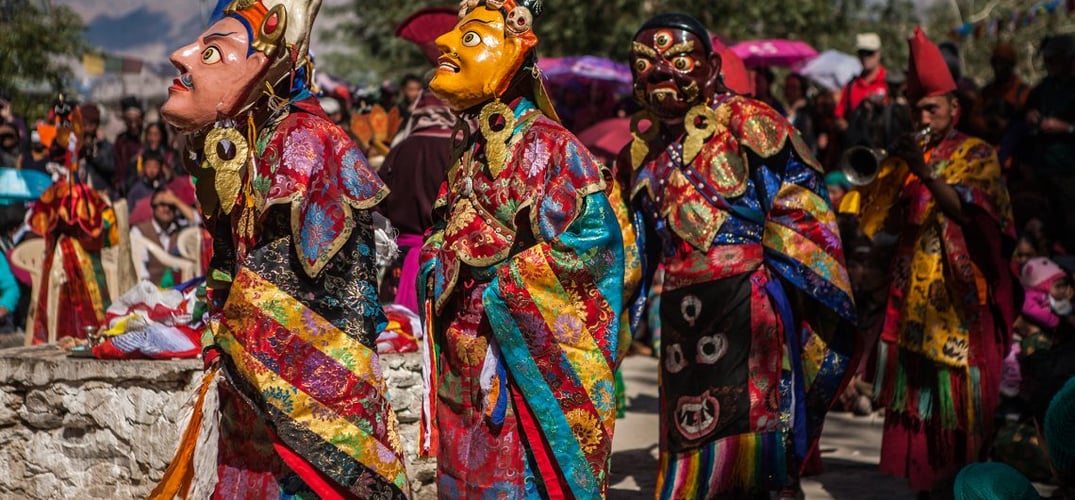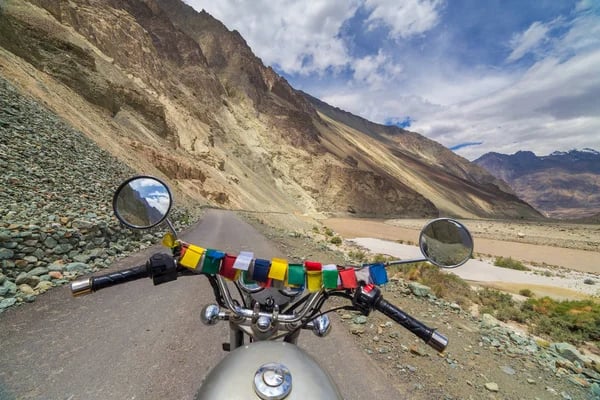Best time to visit Gangtok
Source: https://commons.wikimedia.org/wiki/Category:Clouds_in_Gangtok#/media/File:Gangtok_01.jpg
The Best Time to Visit Gangtok
Magical hill stations conjure scenes of piping hot cups of tea, phenomenal bakeries, snug sweaters, and full libraries. They evoke memories of silent walks broken by the sounds of twigs being crushed under one’s feet, the fragrance of pine and oak, and the fresh air with its crisp white veil gently draping the cliffs. Gangtok, the small capital of the northeastern state of Sikkim, recreates all these images tendering an idyllic escape from harsh city sounds.
Gangtok twinkles with starry lights on clear black nights and beams with thick rays of sunshine during the day. The weather remains pleasant throughout the year, blessed with a mild climate with a generous dose of rainfall, misty mornings, agreeable afternoons, and enjoyable evenings. Home to nature’s bounty and packed with greens, coupled with bells from monasteries and temples alike, it beckons many a traveller with its enthralling beauty.
Best Time to Visit Gangtok:
With an impressive view of the Himalayan peaks, lush bounds, and a sapphire sky, Gangtok draws in tourists like bees to honey. Whether one prefers to watch the pitter-patter of raindrops on windows while curled up with a good book, marvel at the white summits above or silver sheets on the ground, or simply dance with abandon amidst a kaleidoscopic spread of rhododendrons, is a personal choice. Its variation offers a bursting platter of choices for the enthusiastic excursionist.
Gangtok in Spring: March and April propel an air of copiousness with a bouquet of blooms and a mild chill. Cool breezes sharply salute the face, especially the nose and ears, to give way to the golden caress of the sun as the day wears on. The season ripens each day and the clear skies offer spectacular views of the Kanchenjunga, the third-highest mountain in the world. Temperatures range between 11 and 24 degrees Celsius and the cold winds are a reminder to carry a light sweater during this time of the year.
Lampokhari Paryatan Mahotsav: Gangtok sings during spring with the promise of harvest and blossoms heralding new beginnings. The scenic two-and-half-hour drive out of Gangtok to Aritar is replete with a riot of colours.
The Lampokhari Paryatan Mahotsav, one of the most sought-after festivals in Sikkim, is held annually on Lampokhari Lake with thousands of tourists. The two-day affair’s prime objective was to highlight tourism in the captivating districts of East Sikkim. Stage shows including cultural performances, comic skits, poetry competitions, and musical contests, along with flower exhibits, and cooking competitions dominate the festival’s grounds. Furthermore, adventure activities take centre stage with trekking, paragliding, rock climbing, mountain biking, traditional archery matches, and short treks for bird-watching excursions to neighbouring hilltops. The lake is dotted with boats, and its banks with the hooves of horses ferrying children to set points. Food stalls with fire-roasted dry meat, local beers, wine, and a host of delicacies of traditional Sikkimese cuisine from assorted ethnic groups set a vibrant backdrop of a cultural carnival. The festival’s site is encased by a floret overlay, imposing peaks, shiny waterfalls, and an alpine lake.
https://www.instagram.com/p/Bkoatt6hMRJ/?utm_source=ig_web_copy_link
Gangtok in Summer: Temperatures start to soar in summer in May and June along with cheerful banter redolent in the summery air. Deep sapphire skies lie in perfect contrast with the emerald grounds. Abundant sunshine complimented with refreshing draughts brings the mercury to an ideal setting between 16 to 25 degrees Celsius. The hills wear a flamboyant look with the fragrance of the flowers now heavily scenting the summer air. The picture-perfect vistas are a feast for one’s eyes summoning amateur and expert photographers from afar. Many a picnic blanket can be spotted along the river and small nooks in the mountains, with a clear view of crystalline lakes and glittering rivers.
Ganesh Tok: A small Hindu temple constructed in the year 1953 and dedicated to Lord Ganesh, the Hindu God of prosperity and remover of obstacles, Ganesh Tok lies seven kilometres away from Gangtok. The word ‘tok’ means ‘temple’ in the local language. Perched on a hill at an altitude of approximately 6500 feet, bright flags are tied across the quaint temple’s staircase and it is considered a good omen to receive these prayer flags as a gift from well-wishers.
The temple’s tranquillity is equalled by the staggering views it offers of proud snow-dusted peaks with the Kanchenjunga hills glistening under the summer sun, especially in the mornings. Ganesh Tok is aptly called ‘a place where the gods reside’ rendering a sense of peace, calm, and glory all rolled into one bundle.
https://www.instagram.com/p/CuzT9iGBB2_/?utm_source=ig_web_copy_link
Gangtok in Monsoon: July to September in Gangtok witnesses ceaseless thunderous downpours with the sun making a rare appearance. Tourists are cautioned against travelling during this season due to landslides. However, the romance of shrouded skies with misty mornings, thick clouds, and fog over lush sceneries makes a compelling picture. Temperatures range between 17 and 22 degrees Celsius.
Sightseers' sites remain untouched by swarms of travellers and the wet blanket of the monsoon showers its love on unblemished leafy surroundings, setting the ideal ambience to leaf through a dog-eared book while sipping on fragrant tea and biting into a plateful of steaming hot momos. Warm clothes, raincoats, and gum boots are advised to tackle the madness of the rain gods.
Enchey Monastery: Built on a ridge above Gangtok, and fenced by a boulevard of pine trees overlooking the Kanchendzonga range, the small monastery’s current structure was established in 1909. The spot where the shrine stands was sanctified several centuries ago by Lama Drupthob Karpo, a renowned practitioner of tantric art in Buddhism who acquired flying powers and especially flew down here to build a hermitage.
‘Enchey’ means solitary and the Buddhist temple embraces all those who come to its doors in search of serenity. The shrine pays tribute to Lord Buddha, and Guru Padmasambhava, the second Buddha, and devotees hold the gompa in high esteem as they believe their wishes are continuously fulfilled here. It can be spotted from afar by its gleaming golden cupola atop the monastery and the massive prayer hall inside is ornamented with intricately carved pillars and windows, several paintings of Gods and Goddesses, and murals of kings representing the four cardinal directions. The monastery also holds a large collection of manuscripts and masks which are used for ritual dances, especially during the The Detor Cham Festival.
https://www.instagram.com/p/CxZjFPWI4Ht/?utm_source=ig_web_copy_link
Gangtok in Autumn: October and November see air temperatures between 6 and 18 degrees Celsius, and light woollens are advisable in the season. With the monsoon bidding goodbye, the most artistic season of the year descends upon the state, making autumn one of the best times to visit Gangtok. Although the season is short, nature waves its magical wand peeling layers of raw and rugged beauty. Cherry blossoms bloom abundantly under sunny skies revealing the might of the Himalayas.
Goechala Trek: The untrammelled terrain of the Goechala trek is the closest one can get to the Kanchenjunga without going uphill. The hike requires a certain amount of fitness and energy levels. Acclimatization is paramount which usually occurs in Dzongri. The winds are fierce and the ascent is steep; the climb rapidly increases from 6000 to 15,000 feet in a matter of five days.
Nuzzled within the thriving evergreen forests of the Kanchenjunga National Park, the coveted trek zigzags through the dense jungle, vibrant orchids, spotted butterflies, the sacred Tholung Monastery, suspension bridges with bright prayer flags, and a mirror-like Samiti Lake, with birds tweeting in the background. The trek is divided into two parts – the first half is to Dzongri top with panoramic views of summits in Sikkim and Nepal, and the second half enters scenic open meadows and river valleys.
The trek takes one delightfully close to several enormous, unyielding peaks appearing deceptively near, with staggering views. The glimmers of the early morning sun, shine with a golden smile with magnificent reflections of the massifs mirrored in the placid waters of the lake, making the trek truly notable.
https://www.instagram.com/p/CxdUFynyP0A/?utm_source=ig_web_copy_link
Gangtok in Winter: Gangtok remains fairly pleasant even in winter but thick woollens are advised as the temperature fluctuates between 4 to 7 degrees Celsius from December to February. It is rare to find snow in the city, however, it is a few hours’ drive outside Gangtok to view a white wonderland. Glittery nights twinkle over bonfires and Christmas decorations, with a ring of melodious carols reverberating far into the hills.
Red Panda Winter Festival: Winter signals the festive season and the Red Panda Festival, one of the most anticipated cultural events in Sikkim, invites crowds from far and near. Formerly known as the Sikkim Winter Carnival, the festival aims to promote tourism in the state during winter. It was rechristened to honour the state animal.
The streets get a makeover and the festivities start with a parade of different tribes of Sikkim dressed in ethnic attire dancing to drum beats, led by the Red Panda. The procession is followed by six to ten days of revelry with cultural programs such as classical music and folk dances; exhibitions with sales of local handlooms and handicrafts, agricultural products, flowers, organic fruits, and vegetables; photography contests; traditional cuisine with stalls serving food such as Momos, steamed dumplings stuffed with vegetables or meat, Sel Roti, sweet fried dough made from rice flour, Sha Phaley, semi-circular pieces of bread stuffed with seasoned meat and cabbage, and Hard Churpi, cheese made from buttermilk; fashion shows; musical contests; and eco sports activities such as paragliding, hiking, obstacle courses, zip lining, and bike stunts.
https://www.instagram.com/p/Bdz_LqKAoA3/?utm_source=ig_web_copy_link
Gangtok promises a tableau of robust beauty and adventure balanced with a spiritual ring. Nature’s majesty prevails upon the region in large doses which unveils differently with every season. Perhaps there is no particular season earmarked as the best time to visit Gangtok as its moderate climate positions it as an all-season-appeal. Get in touch with Offbeat Tracks to make an enticing itinerary for you, to visit Gangtok for the best time suited to you – after all, Gangtok’s charm lies in the fact that it is the ideal destination to travel to at any time of the year.

-1.png?height=500&name=Untitled%20design%20(14)-1.png)

